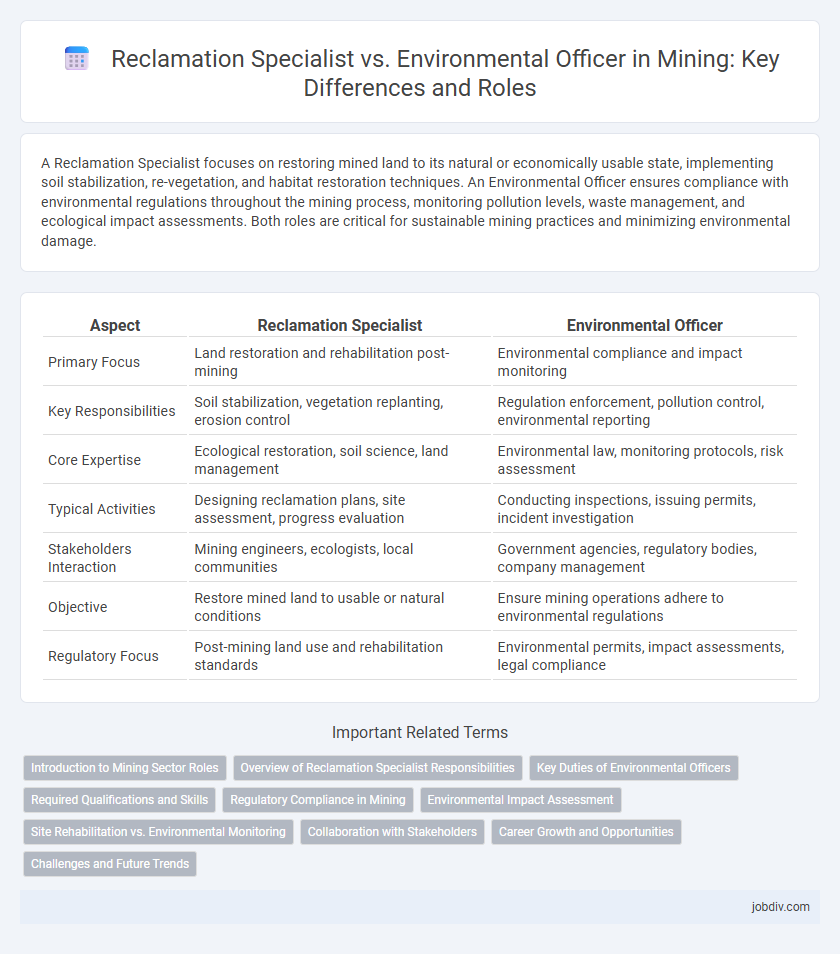A Reclamation Specialist focuses on restoring mined land to its natural or economically usable state, implementing soil stabilization, re-vegetation, and habitat restoration techniques. An Environmental Officer ensures compliance with environmental regulations throughout the mining process, monitoring pollution levels, waste management, and ecological impact assessments. Both roles are critical for sustainable mining practices and minimizing environmental damage.
Table of Comparison
| Aspect | Reclamation Specialist | Environmental Officer |
|---|---|---|
| Primary Focus | Land restoration and rehabilitation post-mining | Environmental compliance and impact monitoring |
| Key Responsibilities | Soil stabilization, vegetation replanting, erosion control | Regulation enforcement, pollution control, environmental reporting |
| Core Expertise | Ecological restoration, soil science, land management | Environmental law, monitoring protocols, risk assessment |
| Typical Activities | Designing reclamation plans, site assessment, progress evaluation | Conducting inspections, issuing permits, incident investigation |
| Stakeholders Interaction | Mining engineers, ecologists, local communities | Government agencies, regulatory bodies, company management |
| Objective | Restore mined land to usable or natural conditions | Ensure mining operations adhere to environmental regulations |
| Regulatory Focus | Post-mining land use and rehabilitation standards | Environmental permits, impact assessments, legal compliance |
Introduction to Mining Sector Roles
Reclamation Specialists in the mining sector focus on restoring disturbed land to its natural state, ensuring compliance with environmental regulations and sustainability standards. Environmental Officers oversee the implementation of environmental management plans, monitor pollution control, and enforce regulatory requirements to minimize mining's ecological impact. Both roles are critical for sustainable mining operations, balancing resource extraction with environmental stewardship.
Overview of Reclamation Specialist Responsibilities
Reclamation specialists oversee the restoration of mining sites by managing soil replacement, vegetation reestablishment, and compliance with environmental regulations to ensure sustainable land use. Their responsibilities include developing reclamation plans, coordinating with environmental officers, and monitoring site recovery to reduce ecological impact. These specialists play a critical role in mitigating mining disturbances and facilitating land rehabilitation aligned with governmental standards.
Key Duties of Environmental Officers
Environmental Officers monitor mining site compliance with environmental regulations, conduct impact assessments, and implement pollution control measures. They oversee waste management practices, ensure rehabilitation plans meet legal standards, and collaborate with regulatory bodies to enforce sustainability. Their key duties include environmental risk evaluation, reporting violations, and promoting best practices for ecosystem protection during mining operations.
Required Qualifications and Skills
Reclamation Specialists require expertise in soil science, ecology, and land restoration techniques, often holding degrees in environmental science, biology, or geology, with strong skills in project management and regulatory compliance. Environmental Officers typically possess qualifications in environmental engineering, environmental management, or a related field, with competencies in environmental monitoring, policy enforcement, and impact assessment. Both roles demand proficiency in environmental laws and excellent communication skills to ensure sustainable mining practices and rehabilitate affected landscapes.
Regulatory Compliance in Mining
Reclamation Specialists ensure mining sites meet environmental rehabilitation standards by developing and implementing land restoration plans that comply with local and federal regulations. Environmental Officers oversee broader regulatory compliance, conducting environmental audits, monitoring pollutant levels, and enforcing adherence to mining permits and environmental laws. Both roles are critical for maintaining sustainable mining operations and minimizing ecological impact through strict regulatory frameworks.
Environmental Impact Assessment
Reclamation Specialists develop and implement land restoration plans after mining activities, prioritizing soil stabilization, vegetation re-establishment, and habitat restoration to mitigate environmental damage. Environmental Officers oversee the Environmental Impact Assessment (EIA) process, ensuring compliance with regulatory requirements by evaluating potential mining impacts on air, water, and biodiversity throughout project planning and operation phases. Both roles collaborate to minimize ecological disruption, with Reclamation Specialists focusing on post-mining recovery and Environmental Officers managing ongoing environmental monitoring and regulatory adherence.
Site Rehabilitation vs. Environmental Monitoring
Reclamation Specialists concentrate on site rehabilitation by restoring mined land to its natural or economically usable state, implementing soil stabilization, revegetation, and erosion control techniques. Environmental Officers focus on environmental monitoring, ensuring compliance with regulations through air, water, and soil quality assessments, and tracking environmental impacts throughout mining operations. Both roles collaborate to ensure sustainable mining practices but specialize in distinct phases of environmental management.
Collaboration with Stakeholders
A Reclamation Specialist collaborates closely with environmental regulators, mining engineers, and local communities to design and implement land restoration plans that ensure sustainable post-mining land use. An Environmental Officer engages with government agencies, indigenous groups, and corporate stakeholders to monitor compliance with environmental laws and promote best practices in environmental management throughout mining operations. Both roles require effective communication and negotiation skills to balance ecological preservation with mining industry objectives, fostering cooperative stakeholder relationships.
Career Growth and Opportunities
Reclamation Specialists in mining focus on restoring disturbed lands to their natural state, offering career growth through expertise in soil science, ecology, and environmental regulations. Environmental Officers oversee compliance with environmental laws and manage risk assessments, providing opportunities in policy development and sustainability initiatives. Both roles present expanding career paths driven by increasing regulatory demands and corporate commitments to environmental stewardship.
Challenges and Future Trends
Reclamation Specialists face challenges in restoring mined landscapes while balancing ecological integrity and regulatory compliance, often dealing with complex soil remediation and habitat reconstruction. Environmental Officers encounter difficulties monitoring environmental impacts, ensuring sustainable mining practices, and managing community relations amid increasingly stringent environmental laws. Future trends indicate greater integration of advanced technologies such as remote sensing, AI-driven environmental monitoring, and enhanced collaboration to improve reclamation outcomes and minimize mining's ecological footprint.
Reclamation Specialist vs Environmental Officer Infographic

 jobdiv.com
jobdiv.com